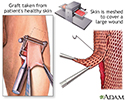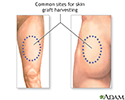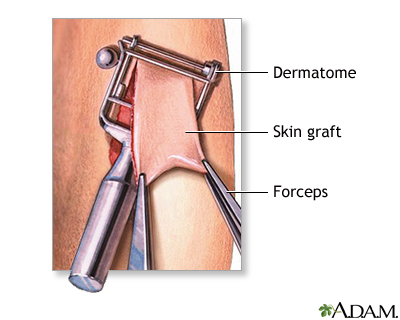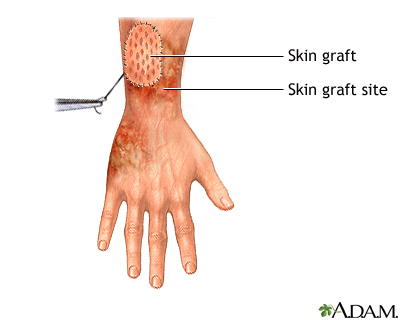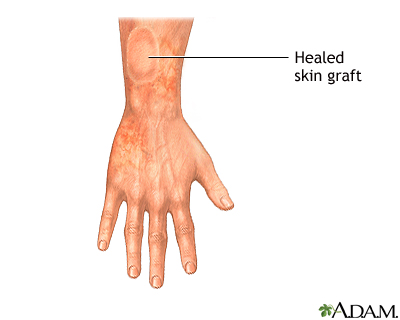Skin graft
Skin transplant; Skin autografting; FTSG; STSG; Split thickness skin graft; Full thickness skin graft
A skin graft is a patch of skin that is removed by surgery from one area of the body and transplanted, or attached, to another area.
Description
This surgery is usually done while you are under general anesthesia . That means you will be asleep and pain-free.
General anesthesia
General anesthesia is treatment with certain medicines that puts you into a deep sleep so you do not feel pain during surgery. After you receive the...
Healthy skin is taken from a place on your body called the donor site. Most people who are having a skin graft have a split-thickness skin graft. This takes the two top layers of skin from the donor site (the epidermis) and the layer under the epidermis (the dermis).
The donor site can be any area of the body. Most times, it is an area that is hidden by clothes, such as the buttock or inner thigh.
The graft is carefully spread on the bare area where it is being transplanted. It is held in place either by gentle pressure from a well-padded dressing that covers it, or by staples or a few small stitches. The donor-site area is covered with a sterile dressing for 3 to 5 days.
People with deeper tissue loss may need a full-thickness skin graft. This requires an entire thickness of skin from the donor site, not just the top two layers.
A full-thickness skin graft is a more complicated procedure. Common donor sites for full-thickness skin grafts include the chest wall, back, or abdominal wall.
Why the Procedure Is Performed
Skin grafts may be recommended for:
- Areas where there has been infection that caused a large amount of skin loss
-
Burns
Burns
Burns commonly occur by direct or indirect contact with heat, electric current, radiation, or chemical agents. Burns can lead to cell death....
 ImageRead Article Now Book Mark Article
ImageRead Article Now Book Mark Article - Cosmetic reasons or reconstructive surgeries where there has been skin damage or skin loss
- Skin cancer surgery
- Surgeries that need skin grafts to heal
-
Venous ulcers,
pressure ulcers
, or diabetic ulcers that do not heal
Pressure ulcers
Pressure ulcer - care; Bedsore - care; Decubitus ulcer - care
Read Article Now Book Mark Article - Very large wounds
- A wound that the surgeon has not been able to close properly
Full-thickness grafts are done when a lot of tissue is lost. This can happen with open fractures of the lower leg, or after severe infections.
Risks
Risks for anesthesia are:
- Reactions to medicines
-
Problems with breathing
Problems with breathing
Breathing difficulty may involve:Difficult breathingUncomfortable breathingFeeling like you are not getting enough air
 ImageRead Article Now Book Mark Article
ImageRead Article Now Book Mark Article
Risks for this surgery are:
-
Bleeding
Bleeding
Bleeding is the loss of blood. Bleeding may be:Inside the body (internally) Outside the body (externally)Bleeding may occur:Inside the body when blo...
 ImageRead Article Now Book Mark Article
ImageRead Article Now Book Mark Article - Chronic pain (rarely)
- Infection
- Loss of grafted skin (the graft not healing, or the graft healing slowly)
- Reduced or lost skin sensation, or increased sensitivity
- Scarring
- Skin discoloration
- Uneven skin surface
Before the Procedure
Tell your surgeon or nurse:
- What medicines you are taking, even drugs or herbs you bought without a prescription.
- If you have been drinking a lot of alcohol.
During the days before surgery:
- You may be asked to stop taking medicines that make it hard for your blood to clot. These include aspirin, ibuprofen, warfarin (Coumadin), and others.
- Ask your surgeon which drugs you should still take on the day of your surgery.
- If you smoke, try to stop. Smoking increases your chance of problems such as slow healing. Ask your doctor or nurse for help quitting.
On the day of the surgery:
- Follow instructions about when to stop eating and drinking.
- Take the drugs your surgeon told you to take with a small sip of water.
After the Procedure
You should recover quickly after split-thickness skin grafting. Full-thickness grafts need a longer recovery time. If you received this kind of graft, you may need to stay in the hospital for 1 to 2 weeks.
After you are discharged from the hospital, follow instructions on how to care for your skin graft, including:
- Wearing a dressing for 1 to 2 weeks. Ask your provider how you should care for the dressing, such as protecting it from getting wet.
- Protecting the graft from trauma for 3 to 4 weeks. This includes avoiding being hit or doing any exercise that might injure or stretch the graft.
- Getting physical therapy, if your surgeon recommends it.
Outlook (Prognosis)
Most skin grafts are successful, but some do not heal well. You may need a second graft.
References
Scherer-Pietramaggiori SS, Pietramaggiori G, Orgill DP. Skin graft. In: Neligan PC, ed. Plastic Surgery . 3rd ed. Philadelphia, PA: Elsevier; 2013:chap 17.
-
Skin graft - illustration
A skin graft is a surgical procedure in which a piece of skin is transplanted from one area to another. Often skin will be taken from unaffected areas on the injured person and used to cover a defect, often a burn. If the area of the skin defect is especially large, the harvested skin may be meshed to stretch it into a larger patch. If the defect involves a great loss of tissue, a full thickness graft, a flap of skin with underlying muscle and blood vessels, may be required. Taking the graft from the injured person makes rejection of the tissue unlikely.
Skin graft
illustration
-
Skin layers - illustration
The skin is the largest organ of the body. The skin and its derivatives (hair, nails, sweat and oil glands) make up the integumentary system. One of the main functions of the skin is protection. It protects the body from external factors such as bacteria, chemicals, and temperature. The skin contains secretions that can kill bacteria and the pigment melanin provides a chemical pigment defense against ultraviolet light that can damage skin cells. Another important function of the skin is body temperature regulation. When the skin is exposed to a cold temperature, the blood vessels in the dermis constrict. This allows the blood which is warm, to bypass the skin. The skin then becomes the temperature of the cold it is exposed to. Body heat is conserved since the blood vessels are not diverting heat to the skin anymore. Among its many functions the skin is an incredible organ always protecting the body from external agents.
Skin layers
illustration
-
Skin graft - series
Presentation
-
Skin graft - illustration
A skin graft is a surgical procedure in which a piece of skin is transplanted from one area to another. Often skin will be taken from unaffected areas on the injured person and used to cover a defect, often a burn. If the area of the skin defect is especially large, the harvested skin may be meshed to stretch it into a larger patch. If the defect involves a great loss of tissue, a full thickness graft, a flap of skin with underlying muscle and blood vessels, may be required. Taking the graft from the injured person makes rejection of the tissue unlikely.
Skin graft
illustration
-
Skin layers - illustration
The skin is the largest organ of the body. The skin and its derivatives (hair, nails, sweat and oil glands) make up the integumentary system. One of the main functions of the skin is protection. It protects the body from external factors such as bacteria, chemicals, and temperature. The skin contains secretions that can kill bacteria and the pigment melanin provides a chemical pigment defense against ultraviolet light that can damage skin cells. Another important function of the skin is body temperature regulation. When the skin is exposed to a cold temperature, the blood vessels in the dermis constrict. This allows the blood which is warm, to bypass the skin. The skin then becomes the temperature of the cold it is exposed to. Body heat is conserved since the blood vessels are not diverting heat to the skin anymore. Among its many functions the skin is an incredible organ always protecting the body from external agents.
Skin layers
illustration
-
Skin graft - series
Presentation
Review Date: 3/13/2015
Reviewed By: Debra G. Wechter, MD, FACS, general surgery practice specializing in breast cancer, Virginia Mason Medical Center, Seattle, WA. Also reviewed by David Zieve, MD, MHA, Isla Ogilvie, PhD, and the A.D.A.M. Editorial team.

